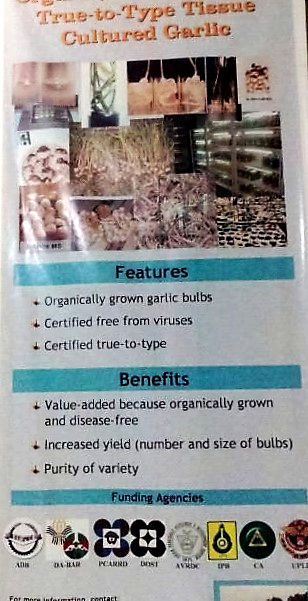The Philippines will revive its apparently demised garlic industry as the Institute of Plant Breeding (IPB) comes up with “mass micropropagation” and “tissue culture” of virus-free garlic planting materials that can boost garlic production.

Breeders have partnered with Ilocos Norte local government unit (LGU) led by Governor Imee Marcos for the technology development on garlic planting materials production.
IPB-University of the Philippines Los Banos (UPLB) has put up the capacity to distribute virus-free planting materials in pilot provinces, according to Dr. Emil Q. Javier, IPB co-founder.
“MMSU and UPLB have installed capacity to produce the required basic virus-free clones. It is a matter of providing the universities the necessary operating funds to sustain operations,” he said in “What to Do with Garlic.”
Javier said that the state universities can subsequently farm out the commercial operation of tissue culture production to private seed companies or cooperatives. This is Bureau of Plant industry Director Vivencio Mamaril pushes for implementation of a garlic development plan.
Tissue culture
Tissue culture is a way of producing numerous disease-free planting materials in the laboratory for mass production in the fields. Different plant parts are extracted from parent plants and grown under aseptic and controlled environment.
At present, the mass micropropagation is done by Department of Agriculture’s (DA) attached agencies.
“The actual commercial propagation of certified virus-free seeds will not be performed by the universities but by designated properly trained farmer seed cooperators/farmer scientists supervised by BPI and Agricultural Training Institute (ATI),” said Javier.
The success of this technology will have a significant impact in improving income of small farmers. At a market price of P80 per kilo minus cost of P40 per kilo, margin is at P40 per kilo or a net income of P160,000 per hectare at a potential yield of 4 metric tons (MT) per hectare.
This is three times most farmers’ income of only P50,000 per hectare from rice farming.

Import dependent
The Philippines is virtually import-dependent in garlic, and smuggling concerns (technical and real) have been a menace for government regulators particularly DA’s BPI.
Imports reached 74,000 MT as of 2015 (Philippine Statistics Authority or PSA) representing more than 90 percent of total supply. Import was valued at $25.43 million.
Success
Nevertheless, with IPB’s technology on virus-free planting materials and its coordination with LGUs and DA, the country has already achieved a certain level of success in raising production.
Ilocos provinces reported a marked increase in local production as of the first quarter of 2017 as the tissue culture technique “originally developed by Lilian F. Patena and National Scientist Ramon C. Barba assured farmers in Ilocos Norte access to clean, healthy seeds.”
Ilocos Region produced in the first quarter 5,100 MT of garlic, contributing 72.5% to the national total.
This became possible with the “bigger bulbs harvested in Ilocos Norte as a result of the availability of more quality seeds from the local government units coupled with favorable wind during bulb formation,” reported the PSA.
MIMAROPA (Mindoro, Marinduque, Romblon, Palawan), mainly Occidental Mindoro, had the next highest garlic production with 21.3% of total in the first quarter followed by Cagayan Valley, 4.3%.
These pushed total garlic production up to 7,030 MT, higher by 3.1% compared to the 2016 output.
Suitable garlic sites
To achieve optimum yield in garlic production, planting should only be done during the “better” season of the year and in suitable locations. One ideal site is in Occidental Mindoro which reports yield of 6.32 MT per hectare, according to Javier, also Coalition for Agriculture Modernization in the Philippines (CAMP) chairman.
“With virus-free planting materials and intensive cultural management, average yields of 5.0 tons per hectare are attainable. These should bring down costs competitive with the ?20 per kilogram landed cost of imported garlic.”
All resources in garlic planting should be poured into ideal provinces. These are Ilocos Norte, Ilocos Sur, Batanes, Nueva Viscaya, Nueva Ecija, Batangas and Occidental Mindoro where “farmers have experience and who need no further persuasion to grow garlic,” said Javier.
Gibberelic acid
Patena said a farmer-cooperator of IPB was also able to achieve high yield in garlic without use of fertilizers.
Felix Valenzuela, in his 1,000-square meter farm in Cabuyao, Laguna hit a harvest of 1,600 kilos. This is effectively equivalent to 16 MT per hectare.
Given stability on this yield from a garlic variety called “Batangas Brown” as assisted by IPB scientists, this could earn for farmers P120,000 per season.
Patena said IPB aided Valenzuela’s farm in the use of gibberelic acid as growth enhancer for garlic production. Gibberelic acid was earlier found to be effective in enhancing mango growth.
The system of using gibberelic acid for garlic growth will further be tested under a multi-location trial, Patena said. (Growth Publishing for IPB-UPLB).
For any questions or interview requests, please contact 0929-715-8669, 0917-102-6734 (Growth Publishing for the Institute of Plant Breeding-UPLB).
